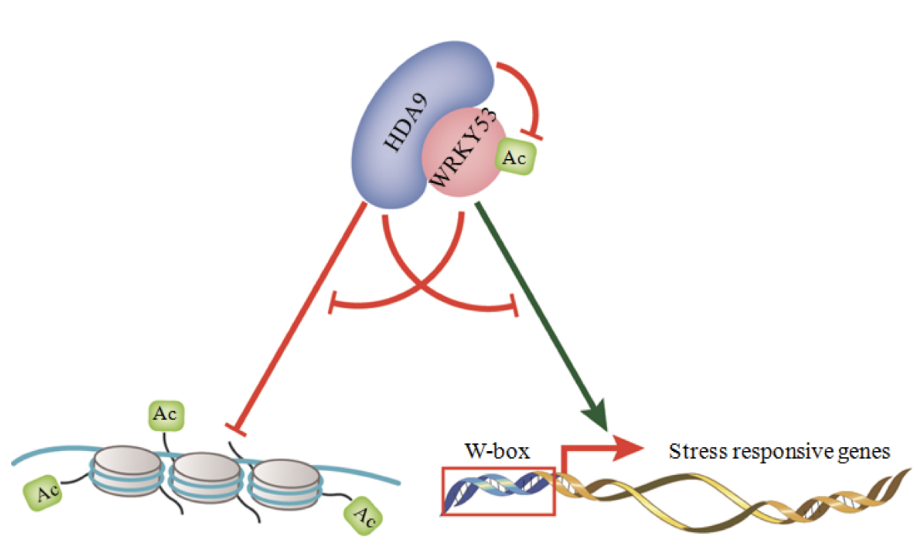博文
Molecular Plant:植物HDA9和WRKY53互作调节胁迫响应
||
Histone deacetylase HDA9 and transcription factor WRKY53 are mutual antagonists in regulation of plant stress response
First author: Yu Zheng; Affiliations: Jianghan University (江汉大学): Wuhan, China
Corresponding author: Dao-Xiu Zhou
Epigenetic regulation of gene expression is important for plant adaptation to environmental changes. Previous results showed that Arabidopsis RPD3-like histone deacetylase HDA9 has a function to repress plant response to stress. The underling mechanism by which this epigenetic regulator targets to specific chromatin loci to control gene expression networks involved in plant response to stress remains unknown. Here, we show that HDA9 represses stress-tolerance by interacting with and regulating DNA-binding and transcriptional activity of WRKY53 that functions as a higher hierarchy positive regulator of stress resistance. We found that WRKY53 is post-translationally modified by lysine acetylation at multiple sites, some of which are removed by HDA9 resulting in inhibition of WRKY53 transcription activity. Conversely, WRKY53 displays a negative function on the HDA9 histone deacetylase activity. The results indicate that HDA9 and WRK53 are reciprocal negative regulators of their activities and reveal functional interplay between a chromatin regulator and a transcription factor to regulate stress tolerance in plants.

基因表达的表观调控对于植物适应环境的变化至关重要。先前的研究显示拟南芥的类RPD3组蛋白去乙酰化酶HDA9具有抑制植物的胁迫抗性的功能。但到底由哪一种表观调控因子靶向特定的染色质区域以控制植物响应胁迫时相关的基因表达网络还不清楚。本文中,作者发现HDA9能够通过与具有DNA结合能力和转录活性的WRKY53相互作用,并控制其表达,而WRKY53是植物胁迫抗性的重要正向调控因子,进而HDA9能够抑制植物的胁迫耐受性。作者发现WRKY53在多个位点具有赖氨酸乙酰化的翻译后修饰,HDA9能够移除其中某些修饰,从而也抑制了WRKY53的转录活性。相反,WRKY53对于HDA9的组蛋白去乙酰化活性也具有负调控作用。这些结果显示HDA9与WRK53是相互的负调控因子,并且揭示了植物中一个能够调控胁迫抗性的、染色质调控因子与转录因子之间的功能互作。
通讯:Dao-Xiu Zhou
个人简介:法国格勒诺布尔大学,博士;1988-1991年,美国加州大学旧金山分校,博士后。
研究方向:植物表观遗传与发育。
doi: https://doi.org/10.1016/j.molp.2019.12.011
Journal: Molecular Plant
Published date: December 27, 2019

https://blog.sciencenet.cn/blog-3158122-1212073.html
上一篇:Nature Genetics:普通菜豆大规模种质资源重测序
下一篇:Nature Ecology & Evolution:植物区域适应和根部微生物群落变异的驱动因素
全部作者的其他最新博文
- • Plant Physiology:CsMADS3促进柑果中的叶绿素降解和类胡萝卜素合成(华中农业大学)
- • Molecular Plant:LBD11-ROS反馈调节作用于拟南芥的维管形成层增殖和次生生长(浦项科技大学)
- • Science Advances:根结线虫通过调控植物的CLE3-CLV1模块,促进侵染进程(日本熊本大学)
- • Nature Communications:油菜素内酯参与植物营养生长期转变的分子机制解析(浙江农林大学)
- • Current Biology:光合作用产生的蔗糖驱动侧根“生物钟”(德国弗莱堡大学)
- • PNAS:花同源异型基因在叶中被抑制、花中被激活的分子机制(南卡罗来纳大学)